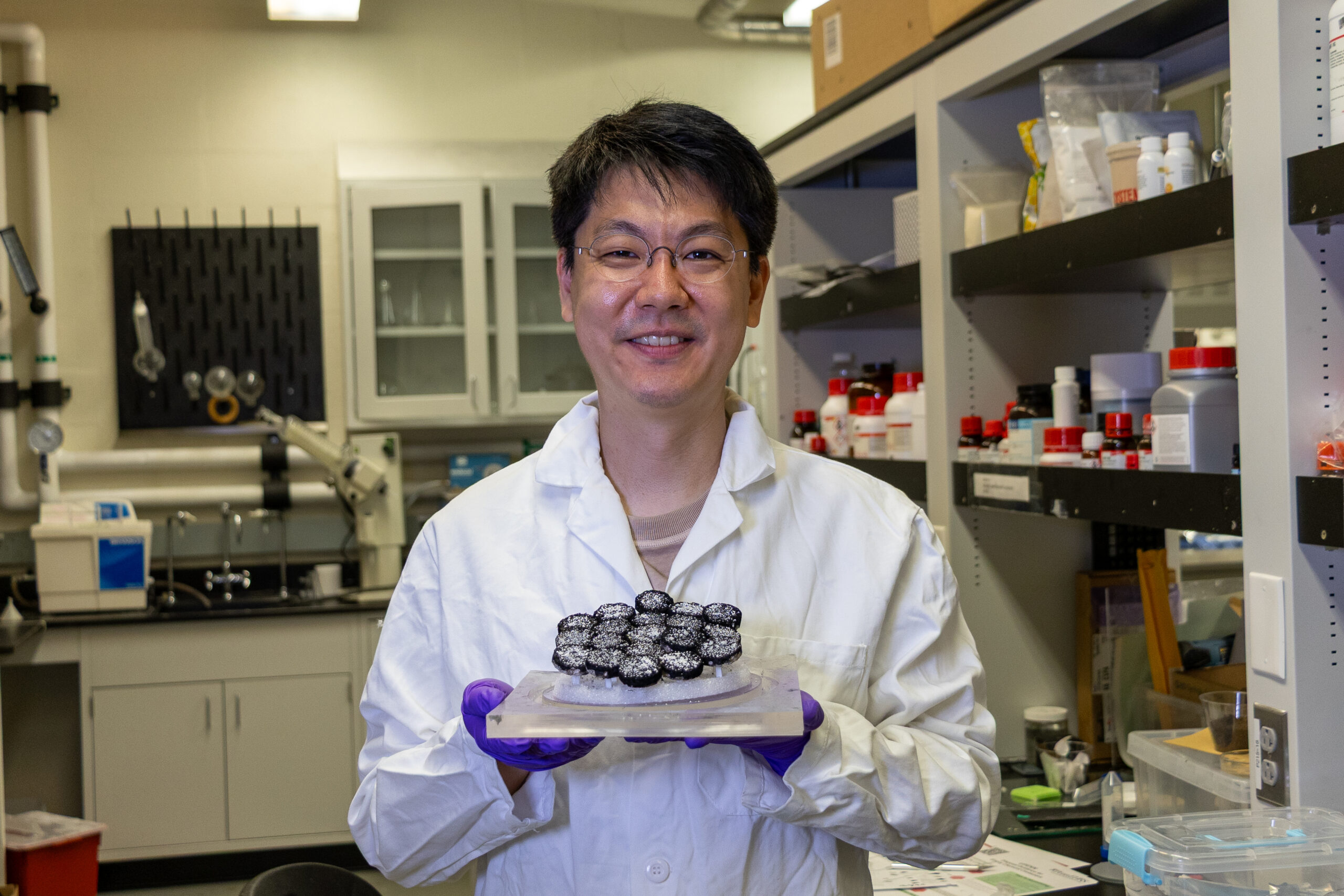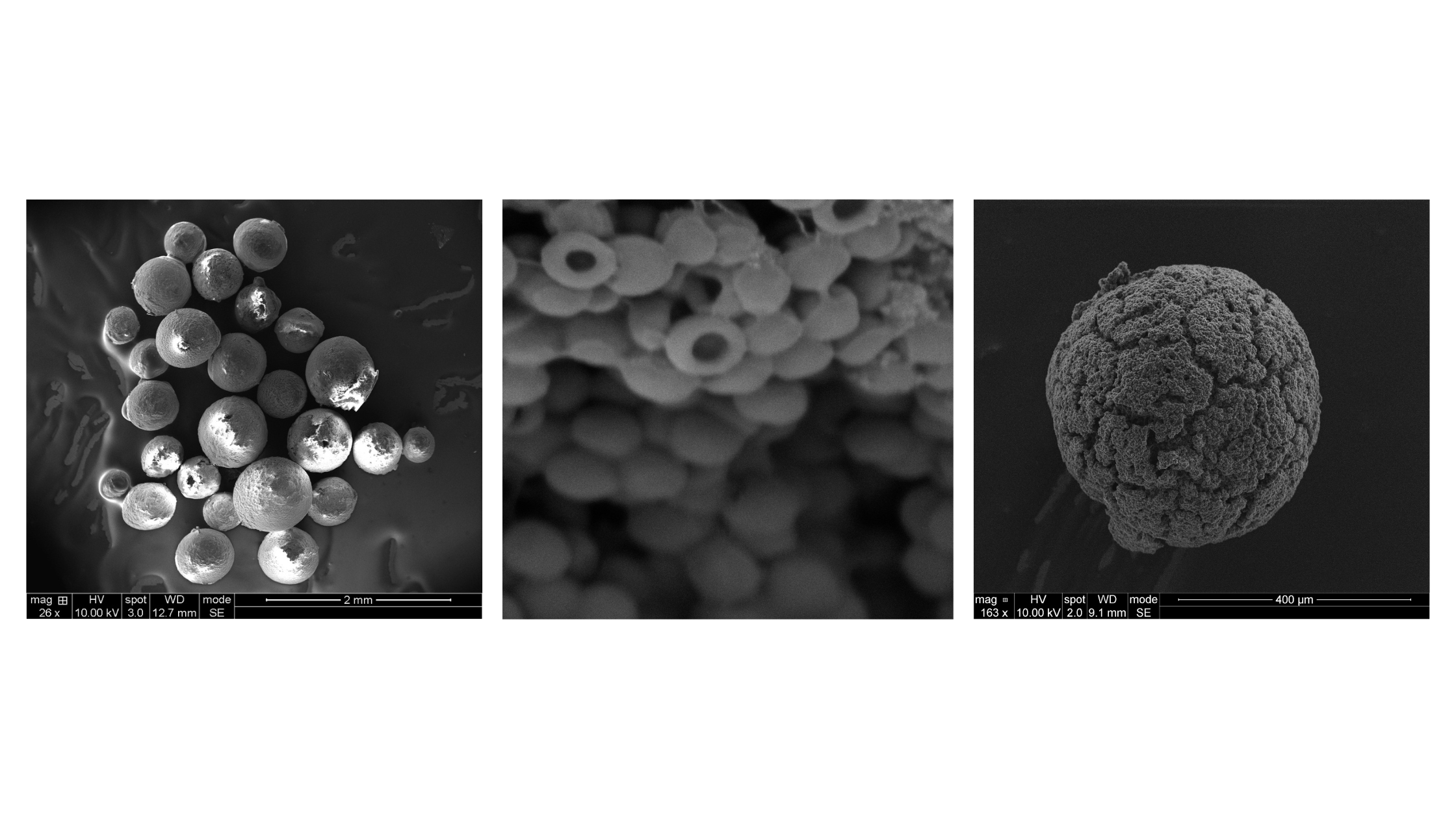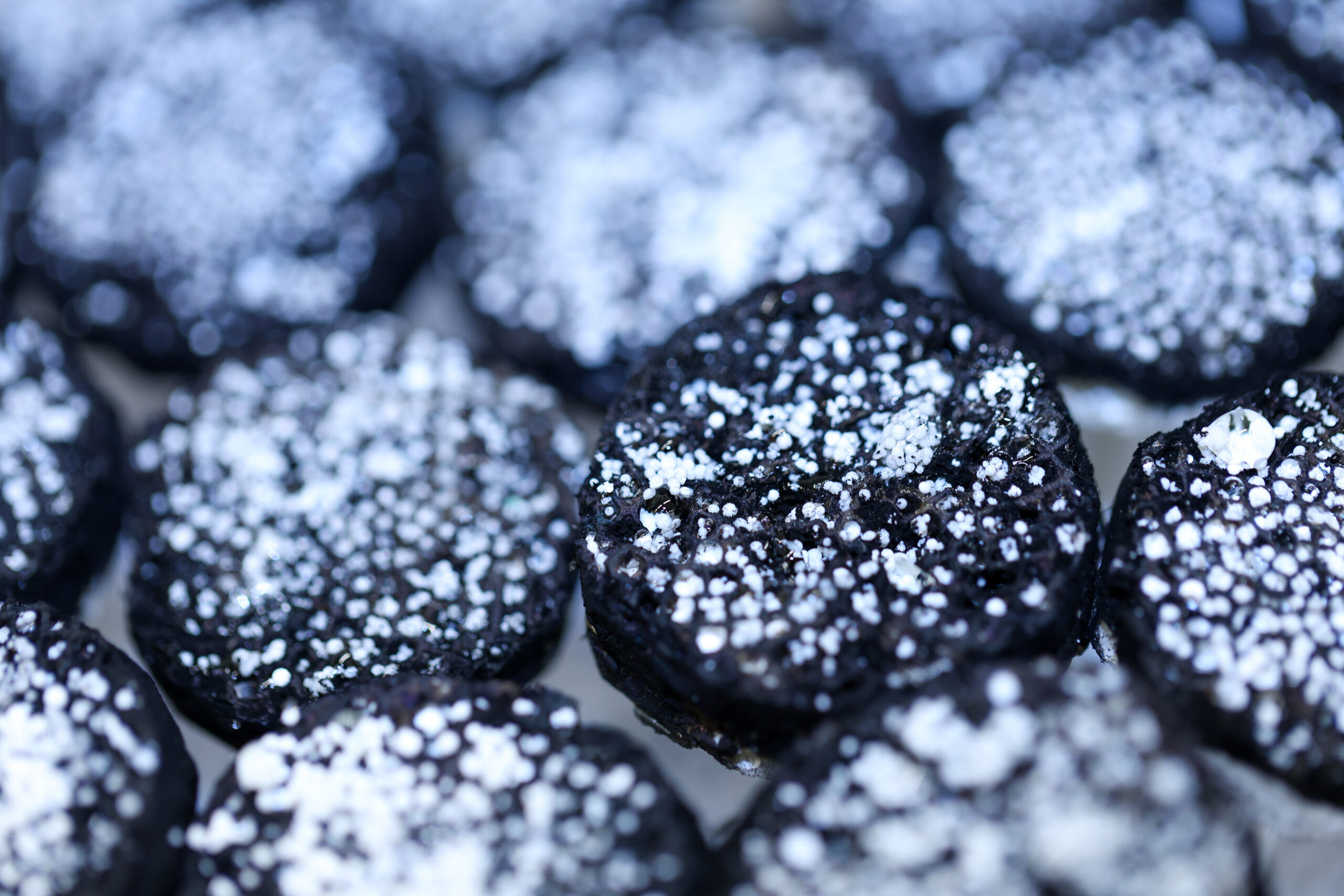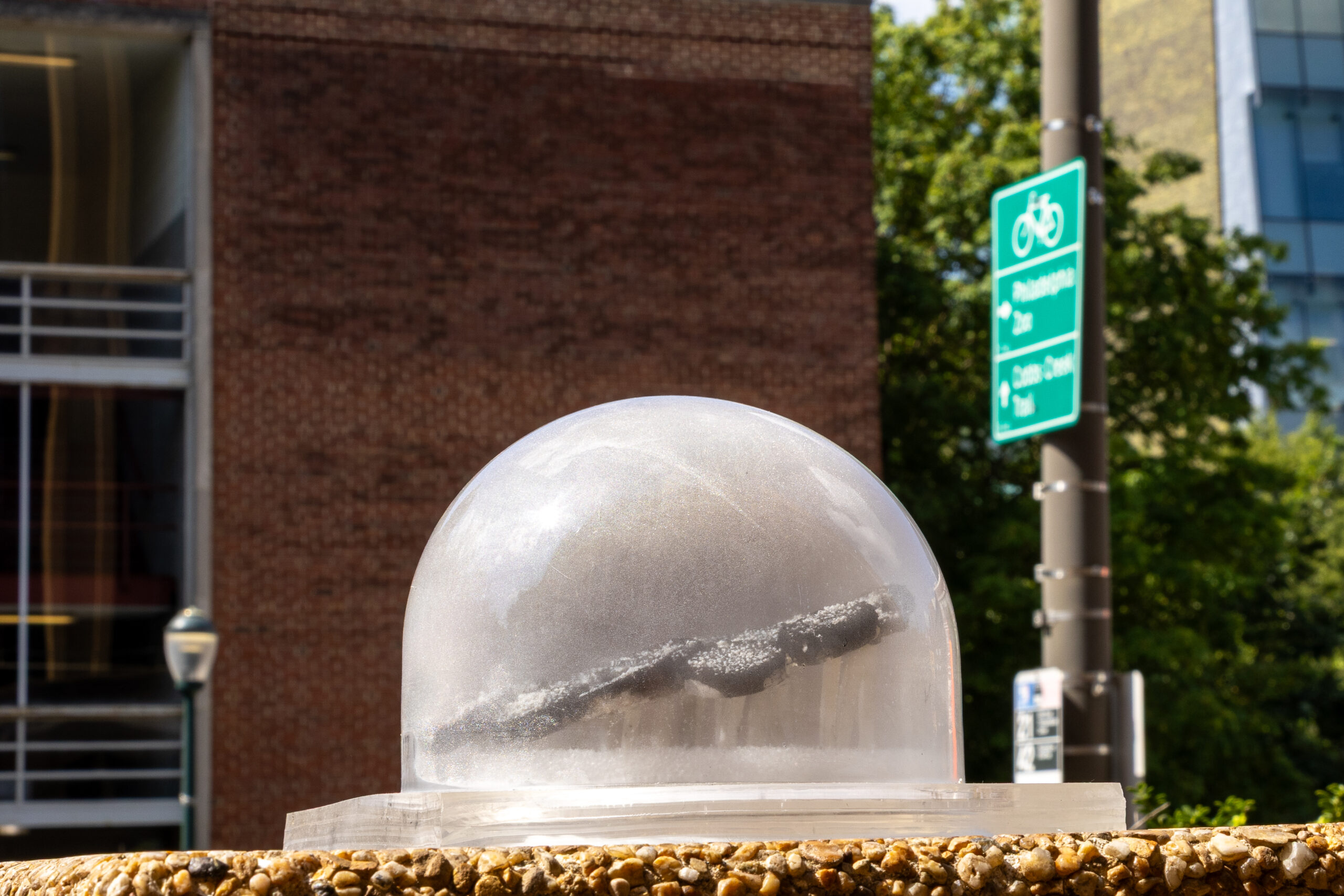Original Article
Tackling large socio-environmental issues like climate change and global freshwater scarcity takes bold, interdisciplinary experts with an eye for natural solutions. Shu Yang, Joseph Bordogna Professor and Chair of Materials Science and Engineering, has already leveraged both her engineering expertise and biomimicry approach to develop kirigami-inspired fog collectors and dehydrating devices for both wood and food. Now, alongside postdoctoral fellow Yunchan Lee, she leads a research team at Penn Engineering that is working to develop a new material and device that imitate two unlikely products of nature: raspberries and sunflowers. Together, these bio-inspired forms make clean, sustainable water harvesting possible by using just the moisture in the air and the heat of the sun.
Published in Advanced Functional Materials, their recent study introduces a scalable, solar-driven water harvesting device that collects moisture from the air using specially engineered, raspberry-like microbeads that are mounted on disks patterned after sunflower seed arrangements.
“A major focus of my lab’s work is water harvesting in eco-friendly ways,” says Yang, who also has an appointment in Chemical and Biomolecular Engineering. “While our fog collectors are great at pulling water droplets from the atmosphere, these devices only work in a few places with fog. In most environments, we have to be able to collect water in its gaseous state. Even deserts have humidity. The challenge isn’t whether there’s water in the air, it’s how to efficiently pull it out.”

From Fog to Vapor: Rethinking Atmospheric Water Harvesting
When Yang and colleagues developed their fog-collecting devices, they relied heavily on geometry as the key to their success. The kirigami structures were designed to create mini vortices that would capture and collect water droplets on the surface of the material. When collecting water vapor, material type becomes extremely important, although choosing the correct material was not exactly straightforward.
Yang and Lee looked at traditional desiccants like silica gel and salts, which can absorb water vapor, but they both come with major downsides.
“Silica gel, like the little packets of beads you find in dehydrated food or packaging for humidity-sensitive products, works slowly, often taking hours to reach saturation,” says Lee. “These materials would also require a lot of energy to release the water once it is collected. Salts are also not ideal. While they are highly hygroscopic, or good at capturing moisture from the air, they are difficult to reuse and are often corrosive.”
So the team explored hydrogels — polymeric materials that swell as they absorb water. Hydrogels are reusable and can retain large amounts of water, but they don’t attract moisture as strongly as salts do.
Their solution? Combine both salt for attraction and hydrogel for retention. But their next challenge was figuring out how to keep the salt from leaching out, which would both contaminate the freshwater collected and hinder the efficiency and sustainability of the device. The answer to this challenge came in the form of a familiar fruit.
Tiny Raspberries, Big Impact
Hollow nanoparticles came to the rescue as spherical traps for the salt, which were then embedded inside hydrogel microbeads. The beads within beads were then assembled into structures resembling raspberries.
“We didn’t set out to make them look like raspberries,” Yang says. “But that’s what they ended up looking like, and it turns out the shape is ideal for water absorption.”
The raspberry-like structure increases surface area dramatically, allowing for faster water uptake. Compared to conventional hydrogel or salt systems, the new material absorbs 4.4 times faster, achieving 80% saturation in just over an hour at 65% humidity.
This kind of performance is rare, and more importantly, scalable.

Sunflower-Inspired Surfaces and the Fibonacci Spiral
Capturing water is just one part of the challenge. The next is releasing it.
To extract the collected water without relying on electricity, the team used solar heat to drive desorption. But when placing the beads outdoors, a new problem emerged: self-shading. If the beads or any part of the substrate they are embedded in block each other, they receive less sunlight and absorb less heat, reducing overall efficiency.
To solve this, the team turned to nature again, this time to sunflowers.
“When this problem arose, we were intentional about our biomimicry approach. We looked to nature to find solutions that already exist and address the problem of self-shading,” says Yang. “We needed a way to expose as much surface area as possible to the sun. That’s when we looked at how sunflower seeds are arranged.”
Sunflowers naturally arrange their seeds in a Fibonacci spiral, a mathematically optimal layout that maximizes light exposure. Mimicking this, the researchers mounted their raspberry beads arranged in the same spiral pattern onto white styrofoam disks, allowing sunlight to hit each bead directly. The disks themselves are insulating and non-absorptive, so the heat is directed where it matters most.
They even coated the disks with polypyrrole, a black photothermal agent, to enhance heat absorption. Under this setup, the team achieved a water collection rate of 2.39 liters per square meter per day, using only the sun, and for only a certain period of the day.
“Picture 10 of these one-square-meter disks placed in your backyard or on a rooftop,” says Lee. “That would collect about 24 liters of water per day. Over a week, just one square meter could generate nearly 17 liters of water, almost filling a 5-gallon water jug.”


V
Engineering Sunflowers for the Future
This sunflower-raspberry system opens doors to a wide range of applications, from clean drinking water in arid regions to new methods for drying food and wood, or even concentrating and sampling air pollutants and microplastics.
“This study aligns directly with my ongoing work on hydrogel-salt composite desiccants, particularly in tackling long-standing challenges such as salt leakage and slow vapor absorption/desorption kinetics,” says Lee. “Inspired by this work, we are now adapting the system for low-energy drying applications, where its rapid moisture uptake is particularly advantageous. We are also developing hybrid desiccant-based energy systems that convert ambient moisture into electricity.”
Yang’s team is also exploring “smart” versions of their sunflowers that will track the sun’s movement like their natural counterparts, automatically adjusting their orientation for maximum efficiency.
“This is about more than water,” Yang says. “It’s about designing full-circle systems that work with nature, not against it, whether we’re collecting water, drying grain or studying air quality.”
This research is sponsored by the Industrial Efficiency and Decarbonization Office (IEDO) in the U.S. Department of Energy under the award number DE-EE0009153. The authors acknowledge the use of Scanning Electron Microscope, Energy Dispersive X-ray Spectroscopy and Raman microscopy supported by the Laboratory for Research on the Structure of Matter (LRSM) and the Materials Research Science and Engineering Center (DMR-2309043) at the University of Pennsylvania supported by the National Science Foundation (NSF). This work was carried out in part at the Singh Center for Nanotechnology, which is supported by the NSF National Nanotechnology Coordinated Infrastructure Program under grant NNCI-2025608. Additional funding support came from the Vagelos Institute Postdoctoral Fellowship provided by the Vagelos Institute for Energy Science and Technology (VIEST) at the University of Pennsylvania.
